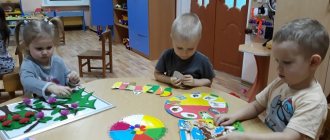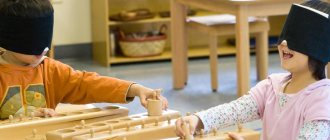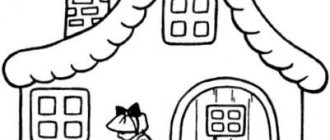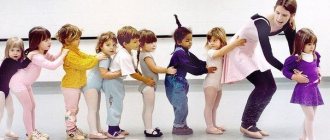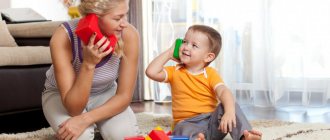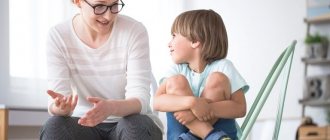In the first years of a child’s life, parents need to make every effort to ensure that the baby can train the abilities of his senses. To do this, it is very important to provide him with the full range of first impressions, thanks to which his psychophysical development will occur much faster and more efficiently. In other words, it is necessary to actively use methods aimed at the sensory development of the child, which we will talk about today.
Experts say that a child is born with natural abilities to understand the world through the perception of objects and phenomena. the growing baby no longer has enough natural abilities to fully Therefore, in the first years of a child’s life, parents need to make every effort to ensure that the baby can train the abilities of his senses, as well as improve them in the future.
To do this, it is very important to provide him with the full range of first impressions, thanks to which his psychophysical development will occur much faster and more efficiently. In other words, it is necessary to actively use methods aimed at the sensory development of the child, which we will talk about today.
What is sensory development and education?
Sensory development (sensory) is the process of forming certain ideas about the properties of objects: their size, shape, color, position in space, tastes, smells, etc. When a baby first encounters the diversity of shapes, colors and events around him (and this happens almost in the very first days of his life), it is important not to miss this time, to help him get used to this world and push him to self-improvement.
It is these goals that are fundamental in the sensory education of a child - a systematic, consistent introduction to the so-called sensory culture. Of course, even without the help of parents, the child, one way or another, knows the world as it is, but this knowledge, without proper sensory development, may turn out to be false or incomplete.
According to experts, sensory development, on the one hand, is the foundation for the overall mental development of the baby, and on the other hand, has a completely independent meaning as a way of developing sensations, perceptions and ideas in children. And it is precisely the early age that is most favorable for the accumulation and systematization of ideas about the world around us and the improvement of the activity of the child’s sense organs.
Development of sensory abilities in children of primary preschool age
How many educational games and toys have been created for our children! Looking at such diversity, I want to be happy for the kids, their parents and teachers.
The best, most educational toys and aids always come from the hands of people close to the child. And if adults also use them in play with the baby, then everything falls into place and the child’s development is guaranteed.
While working in a kindergarten, I was faced with the problem of sensory culture, poor development of the hand and fingers, poor memory of color, size, and shape in children. I decided to set myself the task of developing a child’s sensory culture and creativity. In my group, I created a “Center for Sensory Development”, where I placed manuals and developmental simulators made with my own hands.
With the help of these simulators, children develop thinking, perception, memory, attention, fine motor skills, and an idea of shape, color, and quantity is formed.
The main goal of creating all the benefits is to contribute to the accumulation of a child’s sensory experience through the development of visual, auditory and tactile perception, and to develop fine motor skills of the hand.
I will present some of the sensory aids that I use in my work with children of primary preschool age.
Touch wall
The sensory wall is presented in the form of several aids - simulators that develop sensory abilities in children:
- Sensory dolls.
- Dry rain.
- Geometric cubes.
- Sensory houses.
Dry rain is made of satin ribbons of different lengths and different colors, and colored clothespins. The child takes a clothespin and attaches it to a ribbon of the same color. The child not only consolidates knowledge about colors, but also trains fine motor skills and dexterity.
Dry rain also serves as a retreat room (building self-confidence, reducing mental and emotional stress, enriching perception and imagination.)
Geometric cubes help the child consolidate knowledge about geometric shapes and colors. Shape and size.
Sensory house with geometric shapes - consolidation of knowledge about geometric shapes and color.
A house with colored squares - tactile sensations, (squares made of material of different quality) color.
Sensory dolls: a girl doll is knitted from woolen threads and sewn onto the carpet. She is forced to dress according to seasonal changes. Clothes have snaps, zippers, buttons, hooks, and laces. Children, while dressing a doll, learn to fasten buttons, zippers, hooks, and buttons; tie shoelaces. Children also consolidate their knowledge of seasonal changes. The clown doll is made of fabric. When decorating his costume for a performance, children learn how to fasten buttons, buttons, and tie shoelaces.
Didactic game “Hedgehogs and Little Mice”
The game guide “Hedgehogs and Little Mice” consists of balls of different colors. Half of the balls are made of woolen threads - mice, and half - made of polyethylene - hedgehogs. Balls of three sizes: small, medium, large.
Exercise:
- Find a mouse (hedgehog) of the desired color and size.
- Determine by touch who it is and describe it by opening your eyes.
- Find the mouse's mother.
- Find a hedgehog that is the same color and size as a mouse.
Fishes (knitted)
1. “The fish come to visit.”
Target. Learn to distinguish primary colors.
- Once upon a time there were funny fish. They lived in their own houses. Let's see what kind of fish live in the red pocket house. (The teacher, if necessary, points to the pocket, the child takes out the fish.) In the red pocket live... red fish. (Etc.)
Pisces love to visit each other. (Then the teacher speaks, and the child acts.) The blue fish went to the red house (the red fish went to the blue house, the green fish went to the yellow house, the yellow fish went to the green house). (Subsequently, fish and houses are offered to the child in various combinations.)
It’s good to be away, but at home the fish are waiting for their kids and are bored. And the mother fish are in a hurry to return to their pocket houses. (The teacher takes a large fish of a certain color, invites the child to find its pocket house and put the fish in it.) Mother and baby met, were happy, hugged and went to bed. (By analogy, the child arranges fish of other colors.)
2. “The fish are lost.”
Target. Learn to distinguish primary colors.
— The fish mothers let their babies out for a walk. The kids were happy and began to frolic. (The teacher mixes the small fish.) The kids took a walk and were tired.
But they can’t find pocket houses with mothers. The baby fish were sad and began to cry. Let's find their moms.
(Then the teacher works with each fish separately.) The red baby cries: “Where is my mother?” Where is his mom? Take the baby to his mother's house. (Etc.)
Fishes (made of fabric)
Description: The fish are made from multi-colored cotton children's socks in primary colors. From one sock you get two fish: a large one and a small one. The toe is cut at the heel. The nose part produces a large fish, and the upper part produces a small fish. Buttons are used for the eyes. Each pair of fish is filled with cotton wool (soft fish), cellophane (russling fish), small balls (hard fish), padding polyester and bells (ringing fish). Velcro is sewn to each fish, which allows you to firmly hold it on the base - a sheet of carpet measuring 45 x 45 cm.
Options for game tasks
- Examining the fish, highlighting details (eyes, tail).
- Reinforcing the names of primary colors (by analogy with the tasks in the previous manual).
- Reinforcing the concept of size: big - small (by analogy with the tasks for the previous manual).
- Introducing the concepts of “one - many” and reinforcing them.
To develop tactile and auditory perception, you can offer the game task “Find by sound”.
1st option (for children from 2 to 3 years old).
The fish walked all day. Evening came. It became dark. The big mother fish began to call their babies. (Further work is carried out with each color pair separately.) The red fish called her baby like this. (The adult squeezes the fish in his hands, the child listens to the characteristic sound.) Find a child who answers (sounds) the same way (for example, rustles). (The child finds the right fish by comparing the sounds. Then he takes fish of the same color in different hands and squeezes them.)
Note. It is advisable to squeeze fish filled with cotton last. They don't make sounds. The teacher says: “All the fish have swam away. Only the quietest fish remained. Touch them. (The child squeezes the fish.) The fish are soft.”
2nd option (for children from 3 to 4 years old).
With older children, the game is played on the principle of playing with a wonderful bag. To do this, large (or small) fish are placed in a bag. The child takes the rest of the fish one at a time, makes a sound, and by touch in the bag finds another fish with a similar sound. Game tasks can be accompanied by a poem by E. I. Tikheeva.
There is clean water in the river,
Let's put the fish there
There will be fish playing there,
Swim, wag your tail,
Pick up bread crumbs.
Caterpillar
Description: The playbook consists of 10 circles filled with various materials: cotton wool, sand, peas, buttons, rustling plastic bags, stones (pebbles) and sewn together. This manual is aimed at preventing flat feet in children, as well as for motor activity and tactile sensations.
Tasks:
- Walk along the caterpillar, stepping on each circle, keeping your balance.
- As you step on each circle, guess what it is filled with.
- Find by your feelings in which circle the filler is peas (cotton wool, sand, buttons, rustling plastic bags, stones (pebbles).
- In physical activity: jump over the stream; snake jumping; jumping from side to side).
Tactile palms
Description: Game guide “Tactile palms” The game development guide consists of 8 images of palms made from eight different materials (sandpaper, cork, smooth and ribbed foil, cloth and plastic) of different textures (smooth, prickly, corrugated, rough). The manual is intended for the development of sensorimotor skills in children from 2 to 6 - 7 years old.
Educational and developmental capabilities of the manual - development of tactile sensitivity of the skin of the palms and fingertips of the child; — development of fine finger motor skills; - development of attention, observation, memory; - development of a dictionary of properties and qualities, signs, as well as the development of coherent speech; - development of spatial concepts; — development of mathematical concepts and counting skills; — development of the ability to act according to a model, according to a given condition, independently. In collective games organized on the basis of the manual, the ability to establish contacts, follow the rules, turn and other communication skills.
For children with special needs of psychophysical development, this manual
will be a stimulator of sensorimotor development.
Types of sensory sensations
Sensory sensations are classified into:
- visual (visual);
- tactile;
- olfactory;
- auditory;
- taste.
It is in accordance with them that the child develops concepts about:
- size;
- form;
- color;
- sounds;
- taste;
- smell.
Main tasks of sensory
The main tasks of children's sensory development are:
- formation of correct sensory standards;
- formation of correct perceptual reactions (sensory perceptions);
- acquiring the skills to independently use a system of standards and correctly respond to perceptual processes.
It is important to understand that the sensory education of a child must take into account his age characteristics. With normal development, children under six months, as a rule, observe the movement of objects, make grasping movements, and show interest in bright toys and loud sounds. Over time, the baby begins to become interested in smells and tastes.
From one to three years, a child acquires basic knowledge about the signs of things around him. It is at this age that he develops concepts of shapes, colors, sizes, tastes and smells. In the fourth year of life, the main ideas about the characteristics of objects are mastered, as well as sensory standards . This is the beginning of an analytical perception of objects and events surrounding the child.
How important is it to develop sensory perception?
Experts say that proper sensory education contributes to the harmonious development of a person. The value of sensory is highly valued due to the important results of this process:
- laying the foundations for the development of intelligence;
- laying the foundations of educational activities;
- creating the foundation of all types of memory (visual, tactile, long-term and others);
- increased attention;
- development of observation skills;
- formation of taste preferences;
- development of the aesthetic component;
- facilitating the baby’s compatibility with the real world;
- expanding children's vocabulary;
- development of a rich imagination.
Competent sensory exercises and activities contribute to the orderliness of the child’s ideas about the world around him, which can turn the usual picture of the baby’s life upside down. Therefore, it is so important to direct the perception of the world around us in the right direction from an early age.
Sensory education systems are based on various tasks in accordance with the age of the baby.
- At an early age, knowledge about sensory standards is collected.
- In middle preschool age this knowledge is formed. Children learn to examine objects, identify them into groups, and divide objects into individual quantities.
- For children of senior preschool age, the main task is to prepare for school education (the ability to distinguish sounds and perceive what is written on paper).
Reference system for young children
Sensory standards for children at an early stage of development are considered to be:
- nine primary colors of the spectrum;
- five geometric shapes (square, triangle, rectangle, circle, oval);
- three sizes (sizes) of an object: large, medium, small;
- musical notes, sounds of the native language;
- four tastes (sweet, bitter, salty, sour);
- two temperature definitions (warm, cold);
- five types of smell (sweet, bitter, fresh, light, heavy).
Depending on the age of the baby, the requirements of sensory education require the following knowledge and skills.
For ages 1.5-2 years:
- understanding and ability to name 3-4 colors, as well as correctly select them according to the sample;
- orientation in the sizes (magnitudes) of objects, the ability to disassemble and assemble a three-dimensional matryoshka doll;
- the ability to correctly assemble a colored pyramid of 4-6 rings of different sizes;
- the ability to correctly correlate the configuration of three-dimensional figures with flat ones;
- have basic drawing skills (draw horizontal, vertical, short and long lines, and also clearly explain what he drew).
For ages 2-4 years:
- understanding and ability to name 6 colors, as well as correctly select them according to the sample;
- orientation in 3-5 contrasting values (sizes);
- the ability to assemble a colored pyramid of 6-8 rings of different sizes;
- the ability to correctly form a whole object from 4 parts (cut pattern, folding cubes);
- the ability to clearly distinguish between three-dimensional objects in shape (cube, ball, pyramid, etc.) and flat objects in outline (square, triangle, rhombus, circle);
- the ability to draw short and long lines of different locations within a sheet of paper.
The role of parents in sensory education
Father and mother always play a big role in the child’s sensory development. It is parents who lay in the child’s brain the basis of knowledge and skills for later life. And how parents convey sensory standards to the child will determine his further successful education and life in general.
Experts believe that the ideal time to develop sensory skills is after 1 year of age. The baby becomes inquisitive, everything is quite interesting to him, and proper activities and games with the baby during this period will contribute to his harmonious psycho-emotional and mental development. During this period, the baby is ready to receive information about the world through the senses through direct interaction with an object. And at the first stage it is important to touch, look, smell, listen; at the next stage - compare, sort, contrast (by shape, size, weight, temperature, etc.). This is how standards and ideas about the basic properties of the environment (and the world as a whole) are formed - color, shape, size, weight, surface temperature, etc.
Teachers give parents some recommendations on the development of their child’s sensory senses.
- Daily conversations with your baby, retelling what you saw during the day and discussing events. All conversations must be accompanied by standards. For example, ask your little one to describe the color of the car he saw, the size of the tree outside the window, or the taste of the candy he bought.
- Be sure to answer all your child’s questions. However, the answers should not be generalized. Try to state the essence of this or that answer as clearly as possible for children.
- Teach your baby facial expressions of emotions (angry, cunning, sad, happy).
- Play pantomimes and show animal movements and sounds.
- Engage in physical activity and massage with your child daily. Tactile influence on certain points of the body stimulates mental activity.
- Engage in modeling, drawing, and playing in the sand with children of primary preschool age.
- Get a pet and teach your baby how to care for it (pour water, comb its fur, feed it).
- Buy or make toys and items for sensory development yourself. These can be bags of cereals or pebbles, panels with switches, buttons, ropes with scraps and beads.
When and in what form is it necessary to accustom a child to sensory culture?
It has been scientifically proven that early sensory education has a positive effect on the level of intelligence and the quality of mental development of the child as a whole. Therefore, you need to start accustoming your baby to sensory culture as early as possible (the ideal option is from the age of one, when the baby is most inquisitive and tries to look at, touch, and taste everything).
But it is naturally impossible to force a child to develop and improve himself at this age. All classes must be conducted in the only form accessible to his understanding - the form of a game. However, the game should not tire the baby, otherwise he will quickly lose interest in it. 10-15, and in some cases even 5-7 minutes are enough for the child to take away something useful for himself from the lesson.
